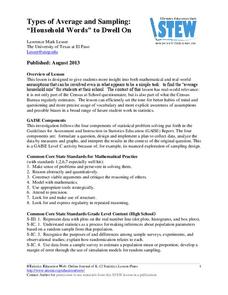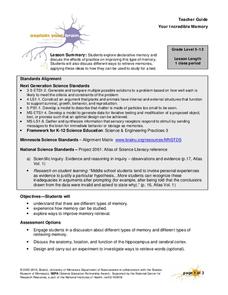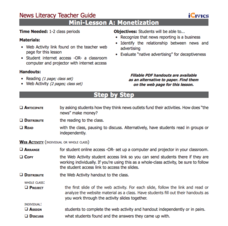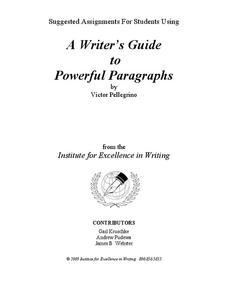Mathematics Assessment Project
Sorting Functions
There's no sorting hat here. A high school assessment task prompts learners to analyze different types of functions. They investigate graphs, equations, tables, and verbal rules for four different functions.
West Contra Costa Unified School District
Families of Functions Sort
Have some fun with functions with a short activity that asks learners to first sort scatter plot in terms of their correlation. They then sort graphs of different types of functions in terms of key features, such as slope.
Statistics Education Web
Types of Average Sampling: "Household Words" to Dwell On
Show your classes how different means can represent the same data. Individuals collect household size data and calculate the mean. Pupils learn how handling of the data influences the value of the mean.
Shmoop
Functions Worksheet 6
Instead of the typical function application problems, learners think a little deeper through these ten problems. Multiple types of functions are represented and the questions add a variety of thinking to practice their skills.
Savvas Learning
Let's Get Moving
Scholars examine, cut, paste, and sort 12 images featuring different types of movement in order to show what they know about energy—potential and kinetic.
CK-12 Foundation
Phases of the Moon
The sun can tell us what time it is with a sun dial, but can the moon do the same? Scholars play with a simulation of the phases of the moon. They control the type of moon and time of day in order to see when the sun is up and when the...
CK-12 Foundation
Collisions
Is momentum conserved in a collision, along with energy, or are they opposing forces? Pupils vary the mass and velocity of two bumper cars along with the type of bumper in order to answer this question. Worksheet and in-simulator...
University of Minnesota
Your Incredible Memory
Test the efficiency of your memory! Scholars test each other's memory as they explore factors that affect memory retrieval. Through experimental analysis, they discover there are different types of memory, which has an impact on the...
CK-12 Foundation
Polynomials and Factoring: Classification Table
It all depends upon the terms. Pupils use the interactive table to sort polynomials. The scholars determine the names for the types of polynomials based on the number of terms.
CK-12 Foundation
Skeletal System Joints: Appendages
The hundreds of joints in the human body fit into five main categories. A quick video explains the joints in the skeleton, which are often the most confusing. The interactive reviews each of the five types of joints and has scholars...
CK-12 Foundation
Graphs for Discrete and for Continuous Data: Discrete vs. Continuous Data
Not all data is the same. Using the interactive, pupils compare data represented in two different ways. The learners develop an understanding of the difference between discrete and continuous data and the different ways to represent each...
Curriculum Corner
February Bell Ringers
Use a set of 30 writing bell ringers to get through the month of February. Writers tap into and write about how February makes them feel, what it smells like, and all types of celebrations that occur during the month.
iCivics
Mini Lesson A: Monetization
Advertising is everywhere! Does your class know that their attention span is for sale, even when they're watching a simple news story? The second installment in a five-part series from iCivics examines the relationship between news...
New York State Education Department
Comprehensive English Examination: January 2015
Looking for practice for state standardized testing? Scholars work through a variety of passages and multiple question types in this exam. Questions range from comprehension of auditory passages, reading passages, and poems, as well as...
Institute for Excellence in Writing
A Writer’s Guide to Powerful Paragraphs
When it comes to teaching writing, it helps to start small. A supplementary guide to A Writer's Guide to Powerful Paragraphs provides suggested activities to help writers craft a variety of paragraphs. Each assignment covers a...
Cold Spring Harbor Laboratory
Some Types of Mutations Are Automatically Repaired
Does natural light damage or repair DNA? Learn the answer discover the scientists who researched the topic with an online interactive. Scholars read through an online animation presenting the content at their own pace. Then, they read...
Alabama Wildlife Federation
Fill the Bill
A hummingbird isn't the only bird with a unique beak. After a discussion about the specific characteristics of bird beaks, pupils complete a station rotation and use different tools to simulate the function of different beaks. They...
Alabama Wildlife Federation
Birds are Everywhere
Wildlife includes all animals that have not been domesticated, both big and small. Young scientists search for all types of wildlife and more importantly for evidence that wildlife is present. As they venture in an outdoor space, they...
Museum of Science
Fingerprints
Capture your unique print. Individuals ink a finger and create a print on a deflated balloon. By blowing up the balloon, pupils get a magnified view of their unique print. They see if they can identify any loops, whorls, and arches in...
Children’s Hospital of Philadelphia
Discovery and Development of Vaccines
Stop the spread. Pupils work through two activities to gain an understanding of vaccines and immunity. Learners research different types of vaccines and how they are made and explore the advantages and disadvantages of them. Using a...
American Chemical Society
Dissolving M-and-Ms
Learning ... how sweet it is! A hands-on lesson uses colored candies to demonstrate how positive and negative charges interact. Pupils use different types of liquids and watch as the color from the candies spreads—or doesn't.
Curated OER
Types of Transportation
Students study different types of transportation including specialized trucks. In this transportation instructional activity, students look at a landscape picture map (not included) and identify all of the modes of transportation they...
Curated OER
Born of Blood
Eighth graders use a large Punnett Square and infer how genes determine blood types. In this blood type lesson students predict blood types and demonstrate how Punnett Squares are related to genes and chromosomes.
Curated OER
Volcanoes
Students use the research the different types of Volcanoes. In this Earth Science activity, students use provided websites to collect information about volcanoes. They work in pairs to review the different types of volcanoes and...
Other popular searches
- Types of Government
- Types of Maps
- Types of Transportation
- Sentence Types
- Types of Sentences
- Types of Conflict
- Types of Triangles
- Types of Volcanoes
- Triangles Types
- Blood Types
- Different Types of Clouds
- 4 Types of Sentences























